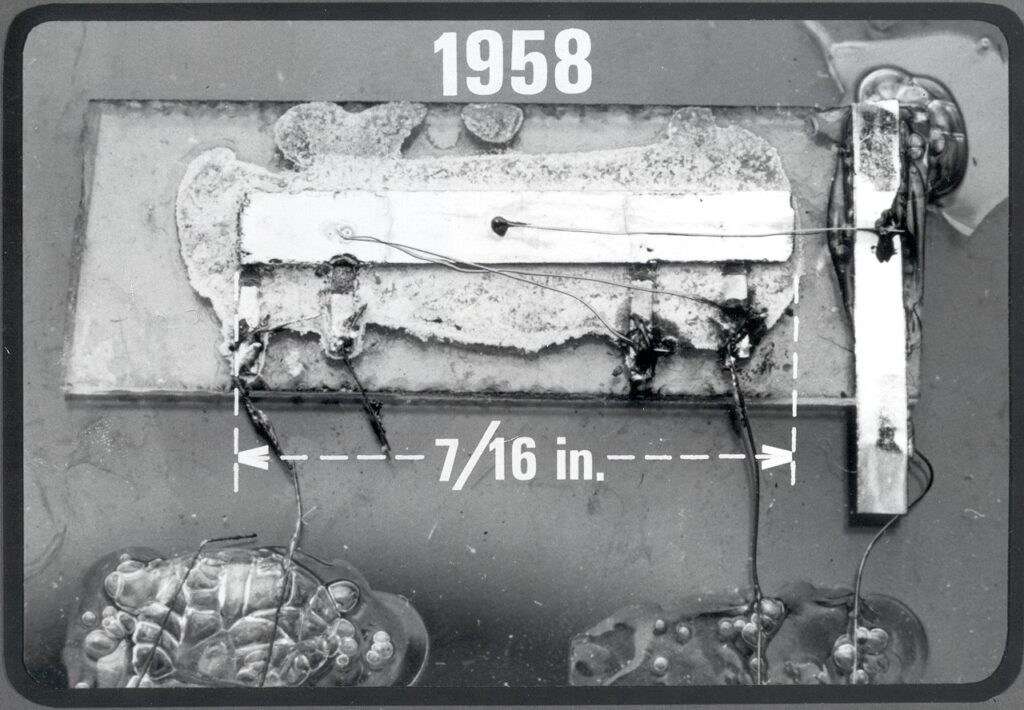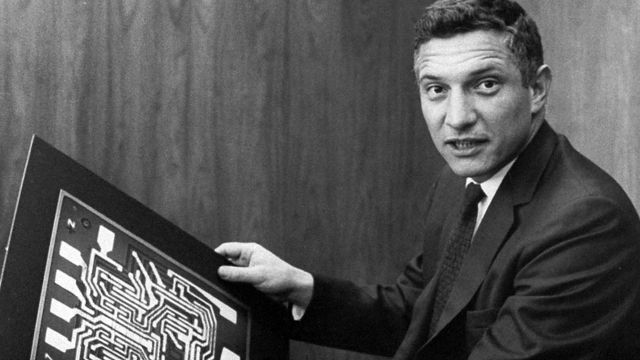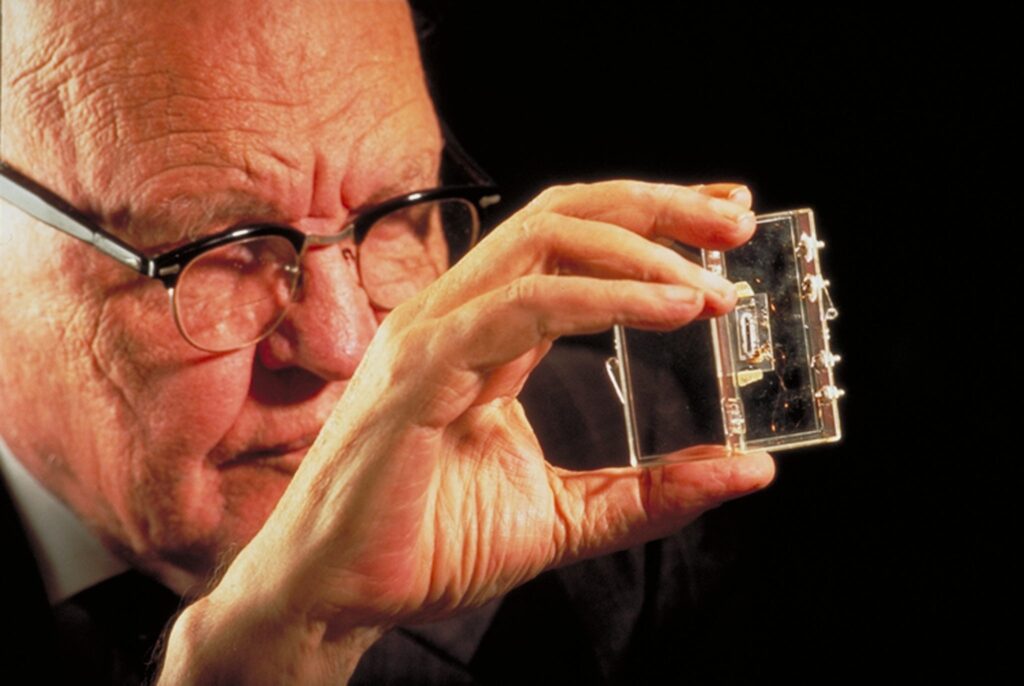Perhaps the most outstanding invention of the past 60 years has been the creation of a semiconductor microcircuit. It was invented in 1958 by American engineers D. Kilby and R. Noyce, the future founder of Intel. Independently of each other, but practically simultaneously, they proposed to arrange individual electronic elements on a common (integral) base made of semiconductor materials. In 1961, Fairchild Semiconductor, headed by R. Noyce, was the first in the world to establish commercial production of semiconductor microcircuits, and since then, microcircuits have been used in electronic technology instead of a large number of transistors. Electronic devices have shrunk in size and new functionality has emerged.
Semiconductors – the beginning of the integrated circuit
Semiconductors are substances that, in terms of their electrical conductivity, occupy an intermediate position between metals and insulators. In electronics, mainly semiconductor materials such as silicon, germanium, gallium arsenide, and selenium are used. The carriers of the current in them are negatively charged free electrons detached from their atomic nuclei; their number strongly depends on temperature. The empty spaces that release electrons were conventionally called “holes” by physicists.
If you connect two layers of semiconductors with different types of conductivity, electrons are displaced from one to the other, leaving “holes” in the first. Between layers with different types of conductivity, there is a so-called barrier layer with increased electrical resistance, since it is depleted of charge carriers, while the properties of the barrier layer can be controlled by applying voltage to it (as well as light).
Combination of semiconductors
The combination of semiconductors with different types of conductivity has other remarkable properties. She can create e. etc. with. (electromotive force) when light falls on the device or, conversely, emit light when a current of a certain polarity passes, generate thermoelectricity, create a temperature difference at different ends (Peltier effect).
Semiconductor temperature sensors, strain gauges (strain gauges ), magnetic field sensors.

Jack Kilby’s original hybrid integrated circuit from 1958
Need to reduce the size of an integrated microcircuit
The tube diodes and triodes invented at the beginning of the 20th century became the basis for a variety of electronic devices – radio receivers and transmitters, amplifiers, measuring instruments and automation.
In addition, any electronic microcircuit contains numerous resistors, capacitors, connecting wires, and often also winding parts and mechanical assemblies. The elements are connected to each other by soldering, sometimes by welding. The equipment was laborious to manufacture and expensive.
Attempts to circumvent these shortcomings were not very successful, and quite naturally physicists and engineers began to look for a different element base.
Invention of the semiconductor diode
At the beginning 1920s began the era of solid-state semiconductor devices. The young physicist O.V. Losev developed the first semiconductor diode – kristadin – in the Nizhny Novgorod radio laboratory. It has been used successfully to amplify and generate electrical vibrations. Later, diodes of other types appeared – rectifier, point, varicaps, zener diodes, tunnel diodes, photodiodes, LEDs, etc.
In 1948, American inventors W. Shockley, W. Brattain and J. Bardeen created a new amplifying semiconductor device – a transistor (triode) with current control, having made a fundamental revolution in electronics. As a result of the use of semiconductor diodes and triodes, the dimensions of the equipment and energy consumption have sharply decreased, and the reliability has increased.
Later (Shockley, USA, 1952 and Tezner, France, 1958) other types of multilayer semiconductor devices were created – the so-called field-effect transistors with voltage control, similar in characteristics to vacuum tubes and having huge gains by power.

Robert Noyce invented the first monolithic integrated circuit in 1959. The chip was made from silicon.
Further work to reduce the size of integrated microcircuits
However, life imperatively required further improvement of electronic devices. Labor intensity of manufacture, consumption of materials and dimensions were still too high. The move to printed circuit boards partially solved these problems, but a large number of individual electronic components set their limitations. It was necessary to minimize the number of soldered joints, which reduce reliability, and the length of connecting conductors, which reduces performance. It was also necessary to somehow get rid of numerous resistors and capacitors, at least partially.
Further progress in electronics is associated with the use of integrated microcircuits. An integrated microcircuit is a miniature electronic device, the elements of which are inseparably structurally connected and electrically interconnected.
“Heart” of an integrated microcircuit is a crystal of a highly pure semiconductor material (most often silicon), in the structure of which complex purposeful changes have been made. Separate areas of the crystal become elements of a complex system. To certain points of the crystal, the pins of the microcircuit are attached (sometimes there are several dozen of them), which are soldered to the printed circuit board of the electronic device. In a crystal, using special methods (diffusion, deposition, etching, etc.) transistors (in a modern microprocessor there are many millions), diodes, resistors, capacitors (of course, in a limited range of capacities).
All processes for the manufacture of integrated microcircuits require high quality materials and precision equipment, the highest culture of production, sterile cleanliness.
Currently, integrated microcircuits are widely used in computers, instrumentation, communication equipment, household electronic devices … Devices based on solid-state and digital technologies are successfully replacing traditional devices. For example, a clock, a camera and a “tape recorder” without moving parts, a flat TV screen became possible. Microchips are even “sewn up” into documents and implanted under the skin. The possibilities of microelectronics are truly immense.

Interesting facts about the invention of the integrated circuit (IC)
- The idea of an integrated microcircuit came to the inventor on one of the July days in 1958 right at the workplace. Since Jack Kilby was hired by Texas Instruments just a couple of months ago, he could not go on vacation, like most of his colleagues. But he was not distracted, and Kilby had plenty of time to think. As the inventor himself told, he suddenly got the idea: what if all parts of the microcircuit, and not just transistors, are made of semiconductor materials and assembled on one board? The Texas Instruments boss liked the idea and asked Jack Kilby to make a microcircuit using a new principle.
- Kilby’s first prototype of the microcircuit, handcrafted, looked very unpresentable. It consisted of a germanium plate and embedded parts of an electronic plate that converts direct current into alternating current. Hanging metal wires were used to connect the blocks. However, after a number of improvements, the integrated microcircuit was ready for serial production.
- Initially, Texas Instruments was slow to patent and commercialize Kilby’s integration principle. The patent was obtained only five months later, on February 6, 1959, amid rumors that competitors, RCA, were going to patent the microchip. The rumors, however, turned out to be false.
- However, history has shown that Texas Instruments was not worried in vain.In January 1959, inventor Robert Noyce, who worked at a small Californian firm Fairchild Semiconductor and at that time did not know about Kilby’s invention, had the idea that the entire electronic microcircuit could be assembled on a single chip. In the spring, Fairchild Semiconductor filed an application with the patent office to protect intellectual rights for a “unitary microcircuit”, where the issue of the connection between microcircuit components was better than Texas Instruments. It is noteworthy that in 1966 Texas Instruments and Fairchild Semiconductor recognized equal rights to an integrated microcircuit to avoid patent wars.
- For his invention of the integrated microcircuit, which made electronics smaller, Jack Kilby won the Nobel Prize in Physics in 2000. He is also known as the inventor of the pocket calculator and thermal printer.
F.A.Q. about The History of The IC
On April 25, the first patent for an integrated circuit was issued. It was received by Robert Noyce. Kilby’s application was still being analyzed at that time. However, today it is recognized that they both came to the idea of creating an integrated circuit independently of each other
More infoTo date, the prototype of Kilby was very primitive, but it worked. On September 12, 1958, Kilby showed the first work of an integrated circuit and applied for its patent on February 6, 1959
More info
